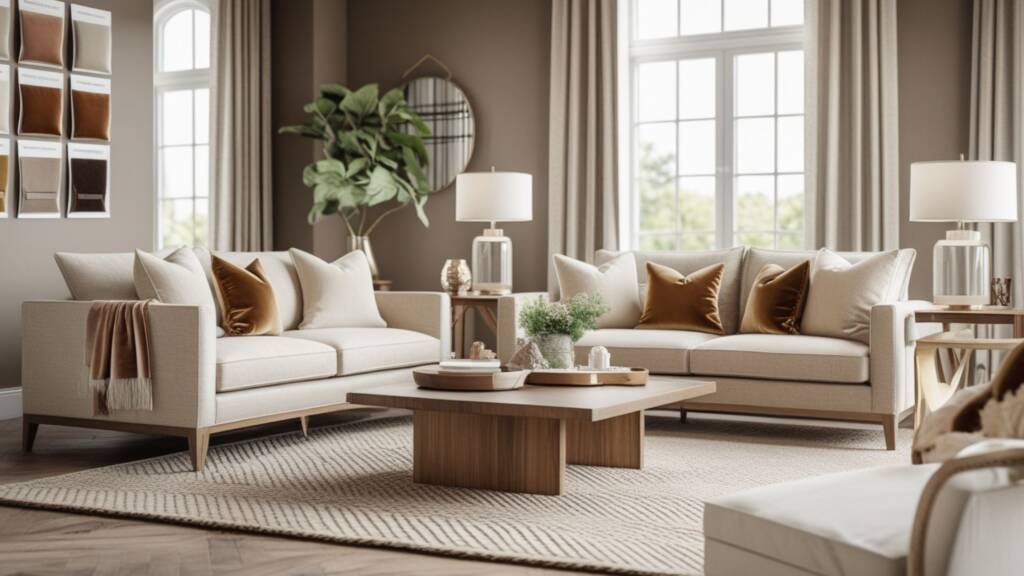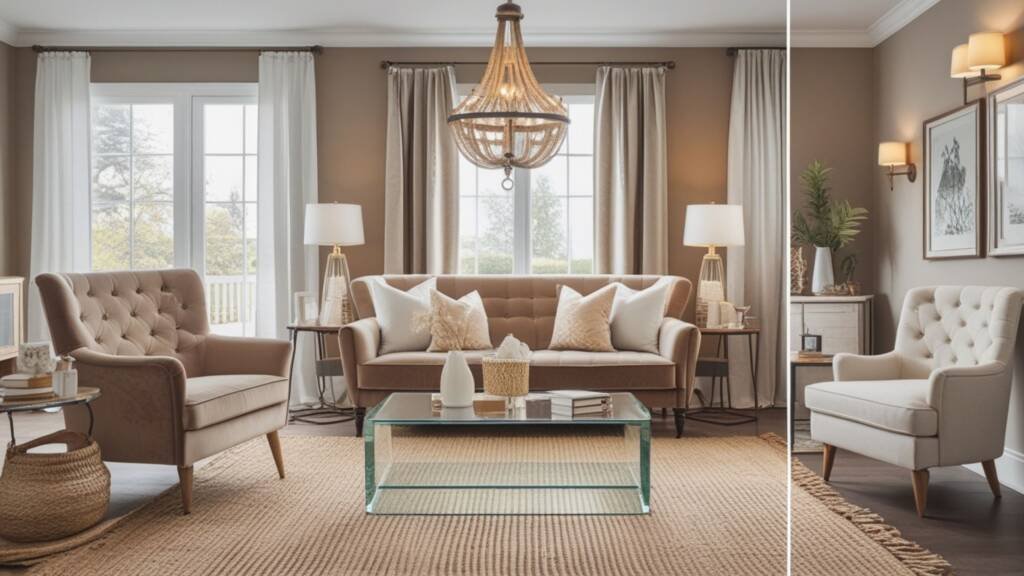Dreaming of a living room that’s warm, stylish, and timeless? Transitional living room style blends the best of traditional elegance and modern simplicity—but how do you make it cosy and affordable? This versatile design trend is loved for its inviting textures and neutral palettes and is a favourite among homeowners. National Kitchen and Bath Association (NKBA) reports that 48% of designers note a surge in demand for transitional style, thanks to its ability to bridge classic and contemporary aesthetics.
Yet, challenges like kitchen to living room floor transitions and budget constraints can feel daunting. Fear not! Our guide reveals how to create a cosy transitional living room and seamless open-concept transitions, even on a budget. From furniture tips to flooring solutions, we’ve got you covered with expert-backed strategies to transform your space.
Table of Contents
Understanding Transitional Living Room Style: A Perfect Balance
What is transitional living room style? As Architectural Digest explains, transitional design combines the warmth of traditional style—think plush furniture and soft textures—with the clean lines and simplicity of modern design. The result is a harmonious, versatile aesthetic that feels both elegant and approachable, perfect for today’s diverse homes.


Core Elements of Transitional Living Room Style
- Neutral Palettes: Beige, grey, taupe and soft whites create a calming foundation.
- Mixed Textures: Velvet sofas, wooden tables, and wool rugs add depth and cosiness.
- Versatile Furniture: Tufted armchairs meet sleek coffee tables for a balanced look.
- Subtle Patterns: Geometric or tonal patterns (e.g., herringbone) add interest without overwhelming.
How It Differs from Other Styles
To clarify, here’s how transitional style compares to traditional and modern designs:
| Style | Key Features | Differences from Transitional |
|---|---|---|
| Traditional | Ornate, rich colors, heavy furniture | More formal; lacks modern simplicity |
| Modern | Stark, minimalist, bold colors | Less cozy; fewer textured layers |
| Transitional | Neutral, mixed textures, balanced elegance | Blends classic warmth with contemporary clean lines |
Why It’s Popular
Transitional style’s versatility appeals to diverse tastes. A 2023 Houzz survey found that 50% of homeowners prefer transitional design for its ability to adapt to various spaces, from small apartments to sprawling homes. Its neutral colours and classic style make it a top choice for creating warm, lasting interiors.
Visual Idea: A mood board showcasing transitional living room decor—neutral sofa, wooden coffee table, textured rug—sets the tone for readers.
The Timeless Appeal of Transitional Living Rooms in 2024
Why does transitional-style living room design resonate so strongly today? In 2024, homeowners crave spaces that are versatile, cosy, and timeless, and transitional style delivers on all fronts. According to Forbes Home, transitional design is a top trend, driven by its warm textures and adaptable aesthetic that create inviting, livable spaces.
Why It Works
- Versatility: Works in any space, from compact urban lofts to suburban homes, per Houzz’s 2023 survey.
- Coziness: Textured fabrics like velvet and warm tones create a welcoming vibe.
- Timelessness: Neutral colours ensure longevity, with 55% of NKBA designers favouring neutral palettes for durability.
Real-Life Example
Imagine a Dallas family who transformed their dated living room into a cosy transitional living room. They changed the bulky furniture for a neutral linen sofa, a wooden coffee table, and a wool rug. This made the space feel warm and modern. Soft grey walls (#D3D3D3) and a transitional chandelier added elegance, proving that transitional living room ideas can elevate any home.
Visual Idea: A photo of a warm transitional living room with plush seating and soft lighting inspires readers to envision their space.
How to Create Your Dream Transitional Living Room
Ready to design a transitional living room that’s both cosy and stylish? Whether you’re working with a small space or a sprawling open-concept layout, these steps will help you craft a timeless, inviting room. Here’s a guide to creating your dream space, complete with budget-friendly tips and a real-life case study.


Step 1: Choose a Neutral Palette
Neutral colours are the backbone of transitional interior design living room style. Opt for calming shades with these hex codes:
- Beige (#F5F5DC): Versatile for walls or upholstery.
- Gray (#D3D3D3): Adds sophistication to furniture or accents.
- Taupe (#8B8589): Perfect for rugs or curtains.
Step 2: Mix Textures
Textures add warmth and depth. Pair:
- Velvet sofas for plush comfort.
- Wooden coffee tables for organic appeal.
- Wool or jute rugs for subtle texture.
Step 3: Select Versatile Furniture
Choose transitional living room furniture that balances classic and modern:
- Tufted armchairs for traditional elegance.
- Sleek wooden or glass coffee tables for contemporary flair.
- Neutral ottomans for functionality and style.
Step 4: Add Soft Lighting
Lighting creates ambience. Use:
- Transitional chandeliers for a touch of glamour.
- Floor lamps with woven shades for warmth.
- Dimmable sconces to adjust the mood.
Budget Tips
- Thrift Furniture: Source wooden tables or armchairs from Craigslist or local flea markets for 50–60% less than retail (e.g., $50 vs. $200).
- Shop Sales: Wayfair and IKEA offer transitional living room furniture sets starting at $100.
- Repurpose: Reupholster old chairs in neutral fabrics for $30–$50.
Case Study: Dallas Living Room Makeover
A Dallas homeowner, Emily, revamped her living room with help from America’s General Contracting. She replaced a dated sofa with a grey linen version ($300 from IKEA), added a reclaimed wood coffee table ($75 from a flea market), and installed a wool rug ($120 from Wayfair). Soft taupe walls (#8B8589) and a transitional chandelier ($150) completed the look. Total cost: $645, proving small transitional living room designs can be affordable. “It’s cosy yet sophisticated,” Emily says.
Expert Insight
John Smith, an ASID-certified designer, notes, “Balance classic and modern by mixing textures like velvet and wood, but keep the palette neutral to avoid overwhelm.”
Visual Idea: Before-and-after photos of Emily’s transitional living room design showcase the transformation, inspiring readers to act.
Seamless Floor Transitions for Open-Concept Transitional Homes
Open-concept layouts are popular in modern homes. Sixty-five per cent of homeowners on Houzz prefer them because they create an open and airy feel. However, kitchen-to-living room floor transitions can make or break the aesthetic, especially with the living room-to-kitchen transitions of different colour flooring. Here’s how to master seamless transitions in transitional living rooms, ensuring both style and functionality.


Why Floor Transitions Matter
A well-executed kitchen living room floor transition maintains visual harmony and prevents tripping hazards. Whether you’re dealing with a sunken living room step-down floor transition or a hardwood-to-tile shift, thoughtful planning is key.
Solutions for Different Flooring
- Carpet to Tile: Use a T-molding strip ($10–$20) for a smooth, flush transition. Match the strip’s colour to the tile for cohesion.
- Hardwood to Tile: Install a reducer strip ($15–$25) to bridge height differences elegantly. Choose a wood-tone strip to blend with hardwood.
- Sunken Living Room: Add a step-down transition with baseboard trim ($5–$10 per foot) for safety and style. Paint baseboards to match walls for a seamless look.
Budget Tips
- Affordable Strips: Transition strips from Home Depot or Lowe’s cost $10–$20, saving 50% compared to custom options.
- DIY with Reclaimed Wood: Create a custom transition strip using salvaged wood for $5–$15.
- Rugs as Bridges: Use a transitional rug for the living room ($50–$100) to visually connect different flooring colours.
Design Tips
- Match baseboards to flooring tones for a cohesive look.
- Use large area rugs to soften abrupt colour changes (e.g., hardwood to dark tile).
- Ensure transitions are flush to avoid tripping, especially in sunken living room transitions.
Example
A Dallas open-concept home faced a living room to kitchen floor transition challenge with oak hardwood and grey tile. The homeowners installed a walnut reducer strip ($20) and added a neutral wool rug ($80) to bridge the colour difference. The result? A seamless, stylish flow that enhanced their transitional living room style.
Visual Idea: A diagram of floor transition types (T-molding, reducer strip, step-down trim) clarifies options for readers.
Pitfalls to Dodge in Transitional Living Room Design
While transitional living room design is versatile, common mistakes can disrupt its balance. Avoid these pitfalls to ensure your space remains cohesive and inviting.
- Overmixing Styles: Too many ornate traditional pieces (e.g., heavy chandeliers) or stark modern elements (e.g., neon accents) can clash. Stick to 2–3 key textures.
- Ignoring Scale in Small Spaces: Oversized furniture overwhelms small transitional living rooms. Choose compact sofas and low-profile tables.
- Poor Floor Transition Planning: Abrupt flooring changes (e.g., dark hardwood to white tile) disrupt flow. Use transition strips or rugs to unify.
- Example: A cluttered living room with a bulky sofa, mismatched rug, and jarring carpet-to-tile transition feels chaotic, missing the transitional mark.
By avoiding these errors, you’ll create a harmonious transitional decor living room that feels both cosy and timeless.
Visual Idea: A side-by-side comparison of a cluttered, incorrect living room vs. a sleek, correct transitional design highlights the difference.
Start Your Transitional Living Room Journey Today
The transitional living room style offers the perfect blend of versatility, cosiness, and timeless appeal, making it ideal for today’s homeowners. From neutral palettes and textured furniture to seamless kitchen to living room floor transitions, this design trend creates warm, stylish spaces that last. Whether you’re refreshing a small transitional living room or designing an open-concept layout, our guide proves you can achieve the look affordably with thrifted finds, DIY transitions, and smart shopping.
Ready to transform your space? Contact America’s General Contracting for expert help in Dallas, TX. Let’s bring your cosy, timeless vision to life!
FAQ: Your Transitional Living Room Questions Answered
What is the difference between transitional and modern living room styles?
Transitional style blends traditional warmth (e.g., plush fabrics) with modern simplicity (e.g., clean lines), while modern is starker, with bold colours and minimal ornamentation.
How do I create a cosy transitional living room on a budget?
Thrift furniture, shop sales at Wayfair or IKEA, and use affordable textures like wool rugs. A neutral sofa can cost as little as $300.
What are the best floor transition ideas for the kitchen and living room?
Use T-molding strips for carpet-to-tile, reducer strips for hardwood-to-tile, or baseboard trim for sunken living room step-down floor transitions. Rugs unify colour differences.
Bonus: Which Transitional Living Room Look Suits You?
Take our quick quiz to find your perfect transitional living room look—cosy, modern, or small space. Answer questions about your budget, style, and space to get personalized recommendations.



